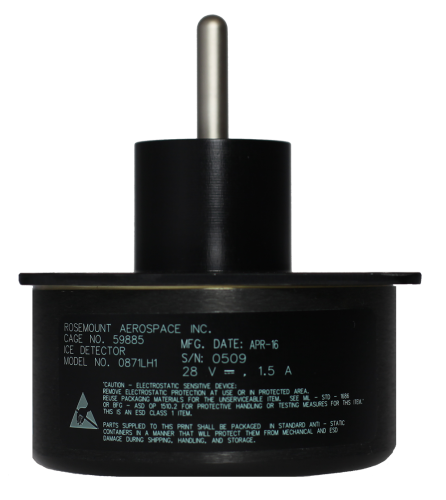
Protects roads, power lines, aircraft, wind turbines






Overview
The 0871LH1, manufactured by Goodrich, is a sensor that detects the presence of icing conditions so that appropriate actions can be taken to prevent damage to power and communication lines, to warn of road hazards, or to keep ice off wind turbine blades or a plane’s wings.
Read More
Benefits and Features
- Can be used to help prevent damage to power lines, and to warn of icy road hazards, ice on planes' wings, and ice on wind turbine blades
- Automatically defrosts itself when ice accumulation reaches 0.5 mm
Images

Detailed Description
The 0871LH1 uses resonant frequencies to determine the presence of icing conditions. Its main component is a nickel alloy rod that has a natural resonant frequency of 40 kHz. As ice collects on the rod, the added mass causes the resonant frequency to decrease. When the frequency decreases to 130 Hz (or 0.02-in. layer of ice), an internal heater automatically defrosts the sensor.
Wind Energy Applications
The 0871LH1 can detect ice on a wind turbine’s blade, which is undesirable because:
- Blade can throw large chunks of ice a considerable distance—an extremely dangerous, potentially lethal situation.
- Formation of ice can cause unbalanced loading on the turbine’s blades, bearings, and gear box.
- Ice reduces the turbine’s power output.
The 0871LH1 can be used for wind prospecting applications by helping predict the amount of time a potential wind power site may be out of commission due to icing conditions. Additionally, the sensor lets users know when ice is preventing their wind sensors from providing data.
Compatibility
Please note: The following shows notable compatibility information. It is not a comprehensive list of all compatible products.
Specifications
| Measurement Description | Ice detected/no ice detected |
| Range | State dependent (ICE = 1, NO ICE = 0) |
| Set Point | Ice signal activates when probe ice thickness exceeds 0.5 mm ±0.13 mm (0.02 in. ±0.006 in.) |
| Output Format | RS-422 output operates at 9600 bps. |
| Operating Temperature Range | -55° to +71°C |
| Storage Temperature Range | -65° to +90°C |
| Random Vibration | 7.9 grms (DO-160C, Category E) |
| Shock | DO-160C |
| Operating Voltage | 18 to 29.5 Vdc |
| Base Diameter | 7.32 cm (2.88 in.) |
| Base Height | 3.81 cm (1.5 in.) |
| Strut Diameter | 3.10 cm (1.22 in.) |
| Strut Height | 2.54 cm (1.0 in.) |
| Plate Dimensions | 7.37 x 7.37 x 0.22 cm (2.9 x 2.9 x 0.085 in.) |
| Rod Diameter | 0.64 cm (0.25 in.) |
| Rod Height | 2.54 cm (1.0 in.) |
| Weight | 0.3 kg (0.7 lb) |
Power Draw @ 24 Vdc |
|
| Sensing Mode | 5 W (maximum) |
| Deicing Mode | 27 W (maximum) |
Operating Modes |
|
| Sensing | Operating with no ice or with probe ice thickness below the set point |
| Deicing | Operating with probe ice thickness exceeding the set point |
Discrete Output Signals |
|
| Ice Signal (No Icing) | Open |
| Ice Signal (Icing Detected) | Ground |
| Status Signal (Operating Correctly) | Ground |
| Status Signal (Failure Detected) | Open |
RS-422 Output Signals |
|
| Ice Signal |
|
| Fail State |
|
Built-in Test (BIT) |
|
| Commanded | Performed at initial power-up. If a failure is detected and verified, the ice detector stops detecting and annunciating icing conditions, the heaters are disabled, and a failure is annunciated. |
| Continuous | Hardware and software BIT verifies that internal electronics are functioning properly. |
Electrical Connectors |
|
| Mechanical | MS27474T10B199PN |
| Mating | MS27474T10B199SN |
Documents
Brochures
Manuals
Frequently Asked Questions
Number of FAQs related to 0871LH1: 3
Expand AllCollapse All
-
The sensor determines if there is an ICE or NO ICE condition. If the sensor is covered in ice, it reports an ICE condition and turns on the heater to defrost itself.
-
This depends on the climate conditions. The maximum heating up time is 25 s.
Privacy Policy Update
We've updated our privacy policy. Learn More